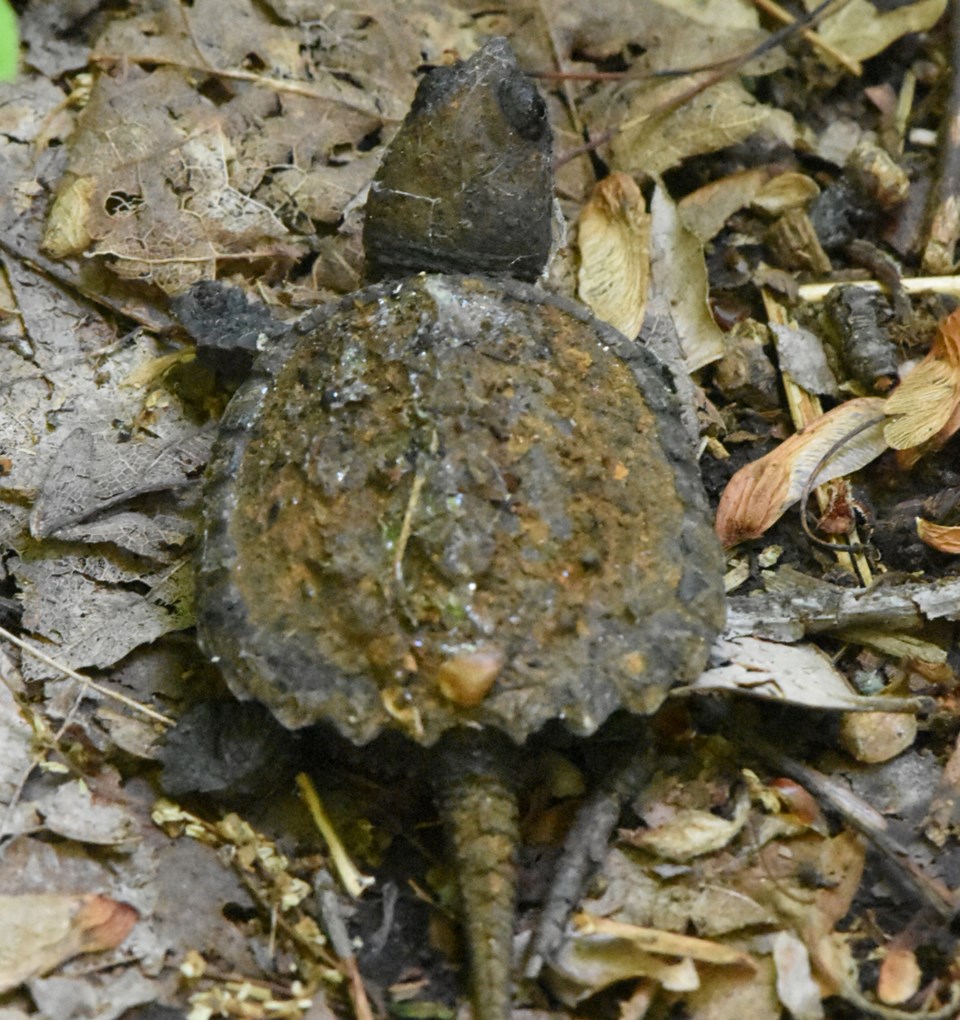Late September is known for many reasons: the noisy overhead “V” formations of migrating Canada geese; the first blaze orange leaves of sugar maple; frosty mornings; the exodus of monarch butterflies and hummingbirds; and bright red apples littering the ground.
There is another event taking place right now, one that hopefully, at least for the participants, goes unnoticed: the arrival of baby turtles.
Back in June the shoulders of cottage roads, gravelly beaches and the shores of beaver ponds were ripped asunder each night as massive and ancient snapping turtles lumbered up and out of the water to lay their eggs. These reptilian ladies were laser-focused on digging a nest hole, depositing their eggs (anywhere from 10 to 40 depending on age and size), covering up their night’s work and retreating back to the still waters for another year.
There are several species of turtles in our area, most commonly the Midland painted turtle and the snapping turtle. Other species are to be found, but their populations are markedly less in number: map turtle, musk turtle, Blanding’s turtle and spotted turtle.
One of the reasons for the declining populations is nest predation. Raccoons in particular, often joined by skunks and foxes, wreak havoc upon these easily detected buffets of raw eggs.
There is a small but very dedicated team of turtle guardians doing volunteer work at the Tiny Marsh Provincial Wildlife Area, and their records of predated nests reveal an astounding number of eaten turtle eggs.
Daily, they walk the shoreline areas and monitor newly dug nests as well as nests that have been dug up and emptied. The wrinkled shells are tallied and the results are staggering ... well over a thousand eggs are eaten each season by raccoons!
The turtle nests that go undetected by the masked marauders (that would be the raccoons I refer to, not the COVID-masked team of volunteers) wait quietly in the summer’s sun. The eggs are incubated by the soil being solar heated, and the temperature of the surrounding soil determines the sex of the incubating egg.
If egg development takes place in temperatures above 20-degree C, you get a female; cooler temps will make a male. While this is a fun fact for us to know, it is a critical event for turtle populations. The eggs near the top of the nest will be females, while the lower tier within the nest will be making males.
And that brings us to September.
The baby turtles hatch from their restrictive egg shell while underground in the nest. Not all at once, but one-by-one, each then clambering upwards to an exit hole. Upon stepping into the sun, each turtle seems to inherently know where to head off to find water.
For me, this is one of those miracles of nature ... the hatchling turtle has no mother to guide it, to teach it how to find food, how to hide from predators, or how to swim. They just know. And sally forth.
But things are not over back at the nest. A new turtle exits the nest a few hours apart, sometimes a day or two apart. Over the night shift come the hungry raccoons again, and the exit hole now emits a delightful aroma of a midnight snack. Again, the numbers of fall predated nests, as recorded by the Tiny Marsh turtle folks, is staggering.
A big picture look is needed here. The eggs at the top are warmed up enough to be female, therefore the first ones out of the nest are female. The late hatchers are male. It is therefore assumed that the females made it to safety by leaving first but the males may get gobbled up. In Nature, there needs to be more females than males to keep the population going forward, a winning strategy that seems to have worked for turtles since the era of dinosaurs.
Research has also revealed that not all the eggs are fertile and many rot in the nest. This is the smell that wafts out the exit hole and drifts into a raccoon’s keen nose.
All the forgoing is to make you aware of this near-autumn event that needs your attention and diligence. For the next few weeks while driving cottage roads or near-shore roads, whether you be in a car, ATV or mountain bike, be very aware for hatchling snapping turtles!
A parting factoid is that the painted turtles often overwinter in the nest: they hatch from the egg in October, survive underground due to a high protein egg sac attached to their lower shell, and emerge next spring. And yes, they freeze solid during the winter months. Again, awesome!
While you are out and about enjoying the sights and sounds of autumn, look up, look down, look all around ... some way cool things are happening out there
